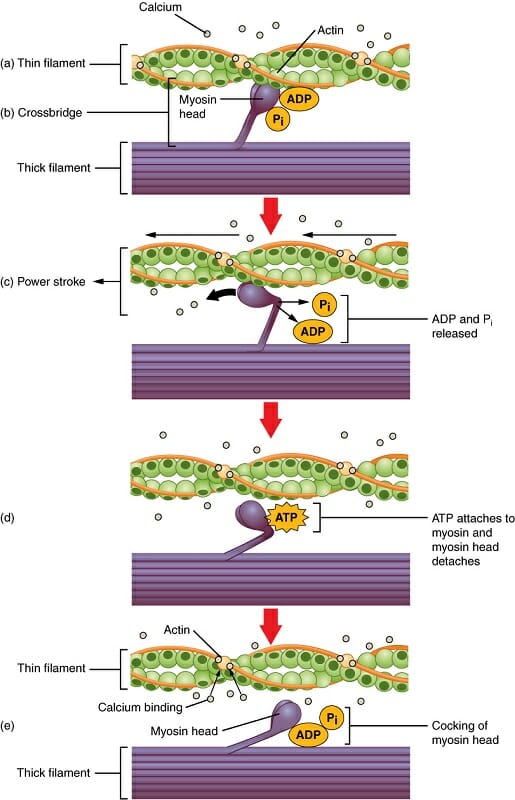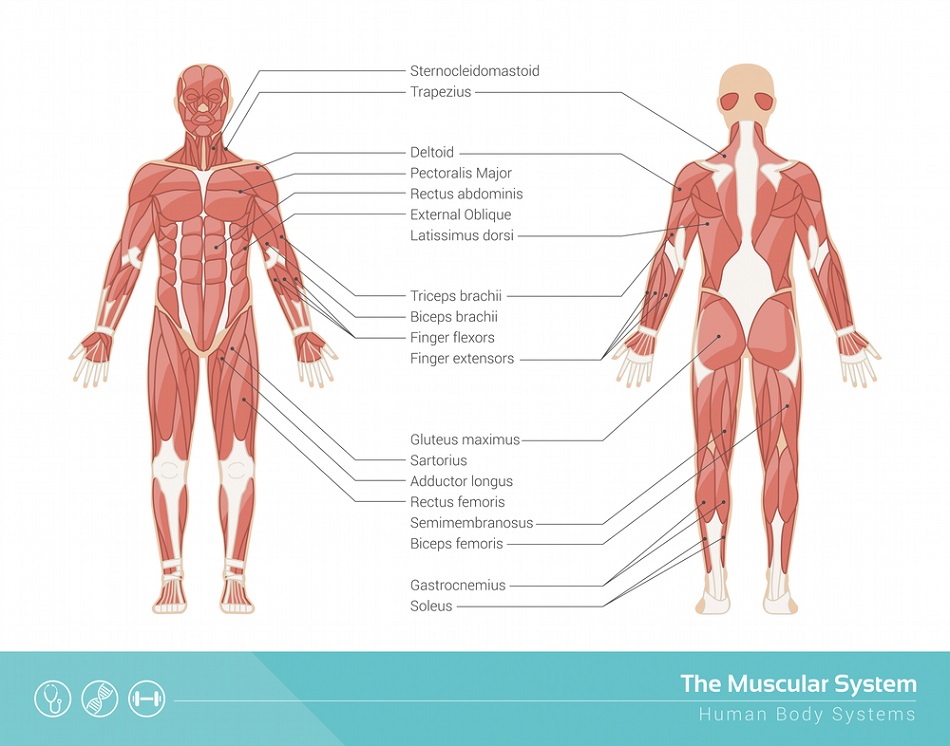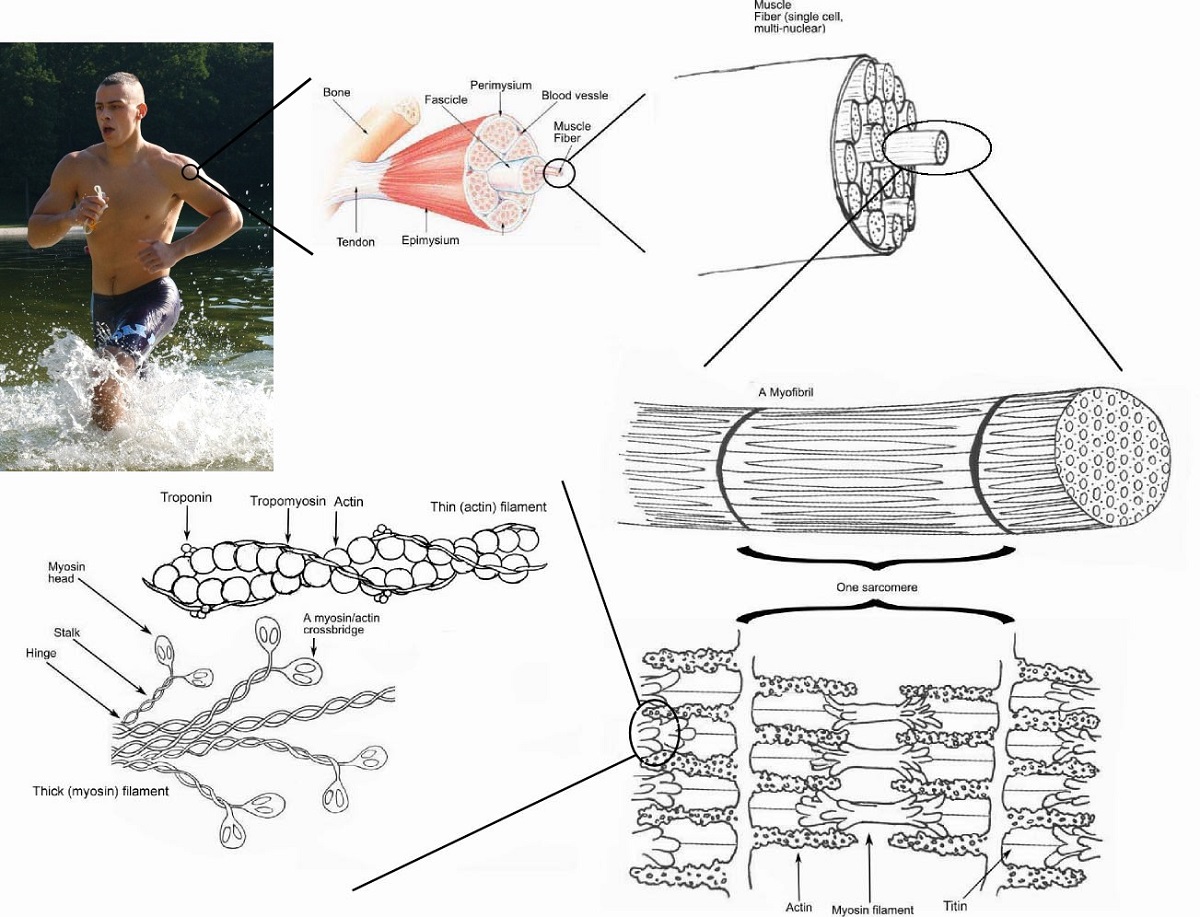Definition
The muscular system is a set of tissues in the body with the ability to change shape. Muscle cells connect together and eventually to elements of the skeletal system. When the muscle cells contract, force is created as the muscles pull against the skeleton.
Overview
Actin and myosin are the main proteins used in muscle cells to produce a contraction. In the image below, actin is seen in green, while myosin is seen in purple. These two components use ATP to pull against each other. They attach to each side of the cell, which shortens the cell as they move past each other.
As seen in the graphic below, the muscular system contracts when energy from ATP is applied to the myosin heads of the myosin protein filament. The head releases the actin, reaches forward, and grips the actin again. This moves the protein filaments and contracts the fiber. Depending on the muscle cell, different forms of actin and myosin can be used. In some organisms, completely different proteins are used.

The muscular system relies on the coordinated action of millions of actin and myosin filaments pulling in the same direction at the same time. To achieve this coordination, muscles are innervated by the nervous system. Nerve signals originating in the brain travel to specific muscles, allowing organisms to stimulate specific muscle tissues to produce coordinated actions like running, swimming, and flying.
Muscular System Function
Movement
The most obvious function of the muscular system is movement. Organisms have adopted a variety of methods to use the contractile function of the muscular system to move through the environment. The most basic movements of fish include contracting muscles on opposite sides of the body in succession. This action propels them through the water.
In organisms with limbs, tendons and other connective tissues are used to secure muscles to the joints and skeleton. Skeletons may be internal like the human skeletons, or they may be external like the exoskeleton of crabs. The nervous system coordinates the contraction of the muscular system to synchronize the movement of the limbs. Animals like the cheetah, swordfish, and bat have obtained speeds above 60 miles per hour or more through the power of their muscles alone.
Circulation
The second and less obvious function of the muscular system is to assist with circulation. Visceral and cardiac muscle tissues surround the blood vessels and lymph vessels that carry crucial nutrients and oxygen to the cells of the body. Cardiac muscle makes up the heart and supplies the main force for blood traveling through the body.
Large arteries and veins have associated muscles which can contract or relax to control blood pressure. The actions of large skeletal muscles also help pump the blood and lymph fluid throughout the body. While you exercise and contract large and small muscles, they push vessels aside, which works like a pump to move fluids around your body.
Digestion
Much like its ability to move fluids through vessels in the circulatory system, the muscular system also aids in moving food through the digestive system. Most digestive organs are surrounded by smooth muscle tissue. Although the tissue cannot be voluntarily contracted like skeletal muscles, it is controlled subconsciously. When food needs to be moved through the gut, the muscles contract in a synchronized fashion in a wave through the digestive system. These wave-like muscular contractions are called peristalsis.
Muscular System Parts
Unlike other organ systems, the muscular system is divided into different types of tissues, which are incorporated into various organs in the body.

Skeletal Muscle
Striated muscle, or Skeletal muscle, is the tissue most commonly associated with the muscular system. This type of muscle attaches to the skeleton and moves the limbs and body of an organism. Skeletal muscle systems are composed of striated muscle which has distinct bands of proteins in each myofibril. When these proteins are given energy, they slide past each other, pulling the ends of each muscle cell together. The sarcomeres, or function units of actin and myosin, produce the banding that can be seen in striated muscle. This can be seen in the image below.

Visceral Muscle
By contrast, visceral muscle cells do not contain these stark bands of protein, and the actin and myosin fibers work differently. Instead of thick fibers than run through the cell, visceral muscle is surrounded by a net of actin and myosin fibers, which squeezes the cell when contracted. This can be seen in the image below. Visceral muscle is also known as smooth muscle for this reason.

Cardiac Muscle
Cardiac muscle, which surrounds the chambers of the heart, is striated like skeletal muscle, but the cells are connected to adjacent cells, which creates more of a contractile motion to pump the blood.
Muscular System Structure
In general, the muscular system has a basic structure which allows muscles to move limbs and create force. A muscle is always situated between two bones, connected to the bones via tendons, which are fibrous and flexible tissues that can attach to bones. The action of each individual cell shortening causes the muscle to shorten as a whole. This pulls on the tendon on each side of the muscle, causing a force on the bones. The bones, if they are connected to a joint, can move in response to this force.
Some bones are stationary, which allows the muscle to pull against them. This is the case with muscles like the diaphragm, which is connected to two stationary bones. When the diaphragm contracts, it forces the air out of the chest cavity because all of the force is directed upward.
Together, the many different types and connections of muscles function to allow your body a complete range of movement. Thus, many muscles cross over each other or are on opposite sides of a bone to move it in different directions.
Muscular System Connections to the Nervous System
Skeletal muscle is connected mostly to the somatic nervous system which is controlled by voluntary impulses from the brain. The cardiac and visceral muscles, on the other hand, are controlled largely by the autonomic nervous system, which controls the subconscious actions of an organism. The separation of these nerve systems ensures that the autonomic functions like breathing and digestion continue to take place as an animal moves about and searches for more food.
The difference in muscular system tissues is due to their very different uses. Skeletal muscles must be able to do a large amount of work quickly, therefore they consist of striated muscle cells, which can contract voluntarily. The smooth muscle tissue found in visceral tissues has fewer energy-producing mitochondria. These tissues are simply used to contract hollow organs and move the fluid inside. The stomach, intestines, and blood vessels are lined with visceral muscles. Cardiac muscle is striated because it needs to produce lots of force, although it is not controlled voluntarily.
Muscular System Diseases
Muscular system diseases fall in a wide range of categories. Simple muscular system injuries can happen, such as tearing a muscle or spraining an ankle. Diseases like tendonitis can happen when a tendon is repeatedly strained. However, there are several muscular diseases not caused by strain or harm to actual muscle cells.
Muscular dystrophy is a genetic disease that affects the muscular system. Beginning at the ages 2-6, the disease persistently weakens the muscles across the entire anatomy. This continues through the remainder of an afflicted person’s life. Generally, people with muscular dystrophy only live into their late teens or early twenties.
Lupus is another disease which affects the muscular system. The symptoms of Lupus include a butterfly-shaped rash on the face, as well as swelling and inflammation of the skin, muscles, and joints. Lupus is an autoimmune disease, meaning the cause of the disease is immune cells within your body creating antibodies against your body’s own proteins.
Quiz
